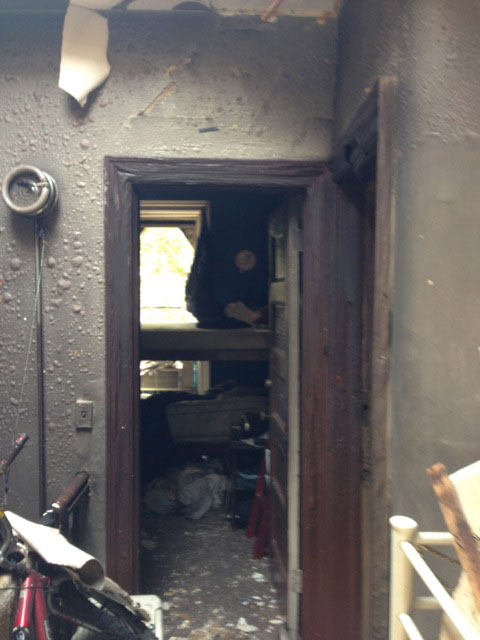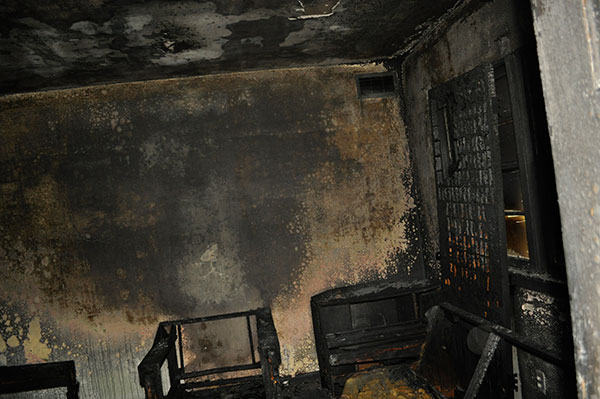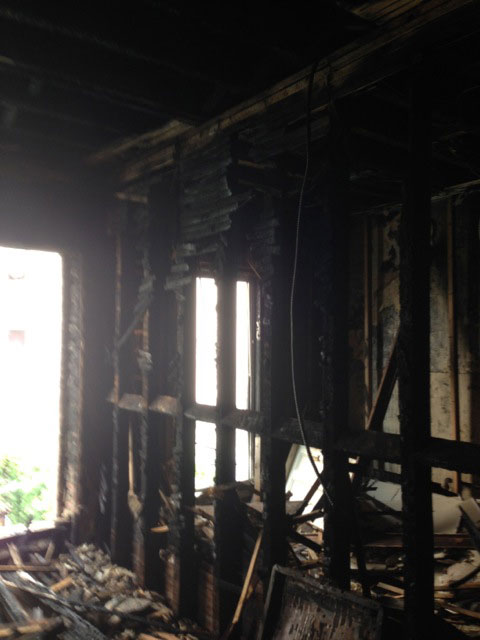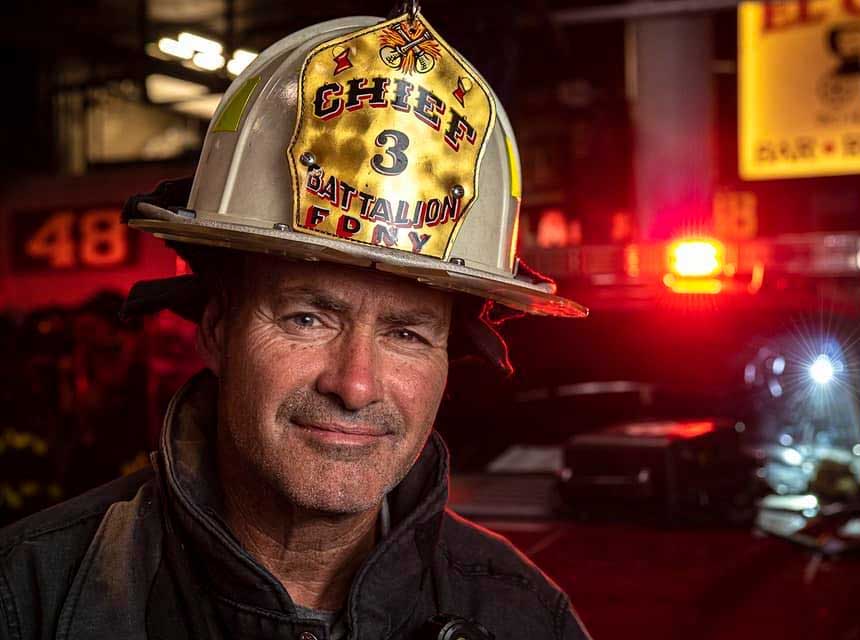By Daniel P. Sheridan and Steve Chasteen
When I came onto the fire department, I was assigned to a ladder company in the South Bronx. I was usually assigned the “can” position. My tools included a 2 ½-gallon extinguisher and a 6-foot hook. The can firefighter’s function is to serve as part of the forcible entry team. Their role is to perform forcible entry, locate and confine fire, and search for victims. After the fire is knocked down, it is their job to perform overhaul (pre-control and post-control).
Pre-control is the time in the fire where the situation is still fluid and although the fire is knocked down it is not “under control.” We are still looking for pockets of hidden fire. This is a critical point in every operation–we have a handle on the fire but need to make sure that we don’t have extension in some hidden void. This isn’t the time to be worrying about how much damage we are doing because we need to get ahead of the fire before we have some serious extension.
That being said, we do need to find a balance and be cognizant of causing excessive damage while operating. Treat every operation as if you were operating at your parents’ house. If we are called for a kitchen fire, say a pot burning on the stove, ask yourself: is it really necessary to break the windows? Do we really need to operate an 1 ¾-inch hose line in a bedroom and flood a room for a mattress fire? I am not at all advocating that we should ever compromise our operation by worrying about breaking some glass or opening a hoseline. I’m just asking: Where’s the balance?
THE DAMAGE DONE
When I was a lieutenant, I was at in a high-rise fireproof multiple dwelling. The fire was in the rear bedroom, a mattress and maybe the dresser, really not a heck of a lot of fire, but enough to warrant the stretching of a 2 ½-inch hoseline (This Fire Department of New York (FDNY) standard operating procedure; we always stretch 2 ½-inch with 1 1/8-inch nozzle for all standpipe buildings). We had a good, quick knockdown. The probie was on the nozzle. Somewhere along the line we had a miscommunication, and we wound up pouring a lot of water in that room. I was in command of that line, so that’s on me.
When you pour that much water on the 13th floor, it cascades down to the basement through every apartment below it. The deputy chief came up to take a look, and I remember him being not so happy with me about the “mini swimming pool” we created in that apartment. I never forgot that lesson and vowed never to repeat that mistake.
FINDING THE BALANCE
Where is the balance? We need gallons per minute (gpm) to combat the British thermal units (Btus). That’s the rule; water puts out fire. We need adequate gpm to remove the heat from the structure. I prefer to get a quick knockdown; once we get a good knockdown on fire, shut down the nozzle, and let it blow for a bit. Let the fire settle, then give it a chance to light up a little before we continuously keep pouring water on it. In the FDNY, we use smooth bore nozzles. To reduce water damage and still cool the room down, we can crack the nozzle a bit and stand about four to five feet back from the window and open the nozzle. This allows you to vent and at the same time you can cool down the room. After we are done venting or if venting isn’t necessary, put a ½-inch tip on the 15/16 nozzle for overhauling purposes.

Photo 1. Outer stream tip
There is a big difference between pre-control overhaul and post control overhaul. Another term for pre-control overhaul is searching for hidden fire or looking for extension. This is where the fire is still ongoing and we start reaching out into areas that we think may also be affected. For example, if we had a fire in a kitchen, I would send a crew up to the floor above to check the walls between the bathroom and the kitchen. This is where the pipe chases are normally found and usually an avenue for extension. Another place to check would be the risers in the room where the heat travels. Any opening between floors needs to be opened up. This is unavoidable. What is avoidable is opening areas where we expect no fire to travel. (As a side note, using the thermal imaging camera does not constitute checking for extension. The best way to check for heat is to put the back of an ungloved hand against the wall, and if it is hot, open it up).

Photo 2. Wall with blistering

Photo 3. Ceilings opened up.
Post-control overhaul is performed after the fire is completely extinguished. This is the time that we are generally more thorough; we open up the walls and window frames to check for the extent of the fire. Usually, when we pull ceilings it would be sufficient to stop pulling when we encounter the clean area. (Photo 3) When I started on the job, we were taught to clean out the whole room, pull all the lathe in the ceiling, trim the windows, etc. This is where we can potentially start destroying evidence that the fire marshals will be looking for. The fire marshals are trying to put the pieces together to figure out the cause of the fire. At this point, slow everything down and think about what you are doing and what actually needs to be done.

Photo 4. V pattern
Every firefighter should know that the base of the V pattern some times points to the point of origin. (Photo 4) This is critical information for the fire marshal to know. If we randomly start destroying the walls for no reason, we may lose a critical piece of evidence. For example, what if there is a kitchen fire and there is a perfect V pattern that points to the coffee maker? What if the gypsum board gets torn down and the coffee maker gets tossed out? Now the fire marshals arrive and all that gone. The gypsum board is in a big, wet pile, and the coffee maker is buried in the pile below the window. What if this coffee maker has a defect that is causing numerous fires, and someone dies because the defect goes unnoticed? This is not out of the realm of possibility. Consider the ramifications of your actions at every incident.

Photo 5. Fire room
The incident commander (IC) is going to be the person that makes the call on whether or not the fire seems suspicious. This IC will also need certain information for the fire, report such as:
- Items first ignited
- Cause of ignition
- Heat source
- Factors contributing to ignition
Finding the balance means getting the job done yet preserving people’s property. I can certainly empathize. Although I was only three years old, I still remember the feeling of losing everything. My mother was supposed to get renter’s insurance, but didn’t have the eight dollars so she put it off for a month. My parents came home one night to find our living room fully involved in fire. She had just bought a new living room set.
Remember, the people we serve are putting all their trust in us to help preserve as much of their property possible. Firefighters all have this sense of honor, or we wouldn’t be in the business that we are in. We can be the difference between a business remaining open or closing its doors simply by being thoughtful in our operation.
The firefighters in New York City are very good at this; we have had three fires in our town in the last month, and by being conscious of the possibilities and consequences of their actions, they were able to keep the two businesses and the one residence from being completely destroyed. The one business was open pretty quickly because the firefighters thought outside the box. While they were fighting the fire, they went to the local hardware store to get tarps to cover the stock in the store. This is truly an example of a high level of professionalism.
FIRE SCENE OVERHAUL vs. DESTRUCTION OF VAULABLE EVIDENCE
Throughout the history of the fire service, a firefighter’s job is to extinguish the fire and then begin overhauling the fire scene looking for “hot spots” and areas of possible fire extension. Firefighters have long been taught at our local fire academy and by the company officers back home about the fine art of “opening up” to prevent the dreaded and always embarrassing call back to the scene a “rekindle.”
This “overhaul” of the fire scene typically results in the ceilings being pulled down and walls stripped of its wall covering. During overhaul, most of the furnishing within the room of origin somehow manages to get tossed out of the windows. Unfortunately, this “overhaul” process almost always results in valuable evidence being destroyed and lost forever. This lost evidence is critical to the fire investigator, who is assigned the job of determining the “origin and cause” for the fire. The time has come to make a serious change in our long tradition.
THE ROLE OF THE COMPANY OFFICER AND THE FIRFIGHTER
When the alarm comes in, the firefighter’s adrenaline kicks in and his brain starts processing an endless stream of information and data. In additional to the usual “stuff” that goes through one’s mind, one piece of information that we received years ago back in the academy gets stuck way down the list of things to do.
Most company officers and firefighters don’t know or don’t realize just how important he or she is to the fire investigator. The first-in firefighters are the eyes and the ears (and in some cases, the nose) for the fire investigator. This is true for any fire scene investigation, regardless if it is an “accidental” fire or an “incendiary” fire.
Although no one expects the first in firefighters to be completely trained and experienced in determining the origin and cause of the fire, the actions of the suppression crews may very well determine the outcome of how and where the fire started. As a fire investigator, I have to seek out the first-arriving firefighters to gather any information they have concerning a laundry list of important items:
- Where did they first observe the fire?
- Did the crews have to force entry into the structure?
- If so, how did they force entry?
- Did they find more than one area of origin?
- How much of the scene (including the contents of the room) has been altered, moved, or destroyed prior to the arrival of the fire investigator?
The list of information that the fire investigator needs is long and detailed!
One of the most important things the firefighters can do is to delay overhauling the fire scene until the fire investigator arrives and has a chance to examine and document the fire scene. When firefighters pull down ceilings or strip walls to the wall studs, the fire patterns that were present on the ceiling or the walls are now gone forever. It is important for firefighters and company officers to realize that fire patterns are considered and used as evidence in a fire scene investigation. The investigator cannot find the evidence when everything in the room has been stripped out, pulled down, and tossed out the window. (Photo)
As a fire investigator, I teach company officers and firefighters the importance of delaying and controlling overhaul. It is important that all fire department members operating on the fireground be aware that everything in and around the fire scene should be considered as potential evidence. That evidence becomes an even greater priority if one of our members gets injured or killed at the scene of a potential arson fire. Remember, we can’t catch the arsonist without evidence to prove an “incendiary” fire. The company officers and firefighters all play a huge role in every fire investigation.

Daniel P. Sheridan is a 25-year veteran of the Fire Department of New York and a covering battalion chief assigned to Division 6 in the South Bronx. He is a national instructor II and a member of the FDNY IMT. He is a consultant for www.mutual-aid.org.
Steve Chasteen has been in the fire service since 1972 serving as a volunteer firefighter and a full time career firefighter and company officer for more than 27 years for the city of Bloomington (IL) Fire Department. He worked as a municipal fire investigator for the fire department for a number of years prior to returning to suppression duties, and has also worked as a private fire investigator for the insurance industry, conducting fire investigations for the past 30 years. He is one of the lead instructors for the Fire/Arson Investigation Training Program with the University of Illinois Fire Service Institute in Champaign, Illinois.
MORE FIRST-DUE BATTALION CHIEF
RELATED FIREFIGHTER TRAINING
- INTEGRATING ARCHAEOLOGY AND PHOTOGRAMMETRY WITH FIRE INVESTIGATION
- OVERHAULING FOR SUCCESSFUL FIRE INVESTIGATION
- Will Your Fire Investigation testimony hold up in court?
- THE ARCHEOLOGY OF FIRE INVESTIGATION
- PRESERVING THE FIRE SCENE: TIPS FROM LAW ENFORCEMENT
- INCIDENT COMMANDER’S GUIDE TO PRESERVING evidence
- AFTER THE FIRES OUT: SPOLATION OF EVIDENCE AND THE LINE FIREFIGHTER
- Free Firefighter Training: Evidence Preservation

